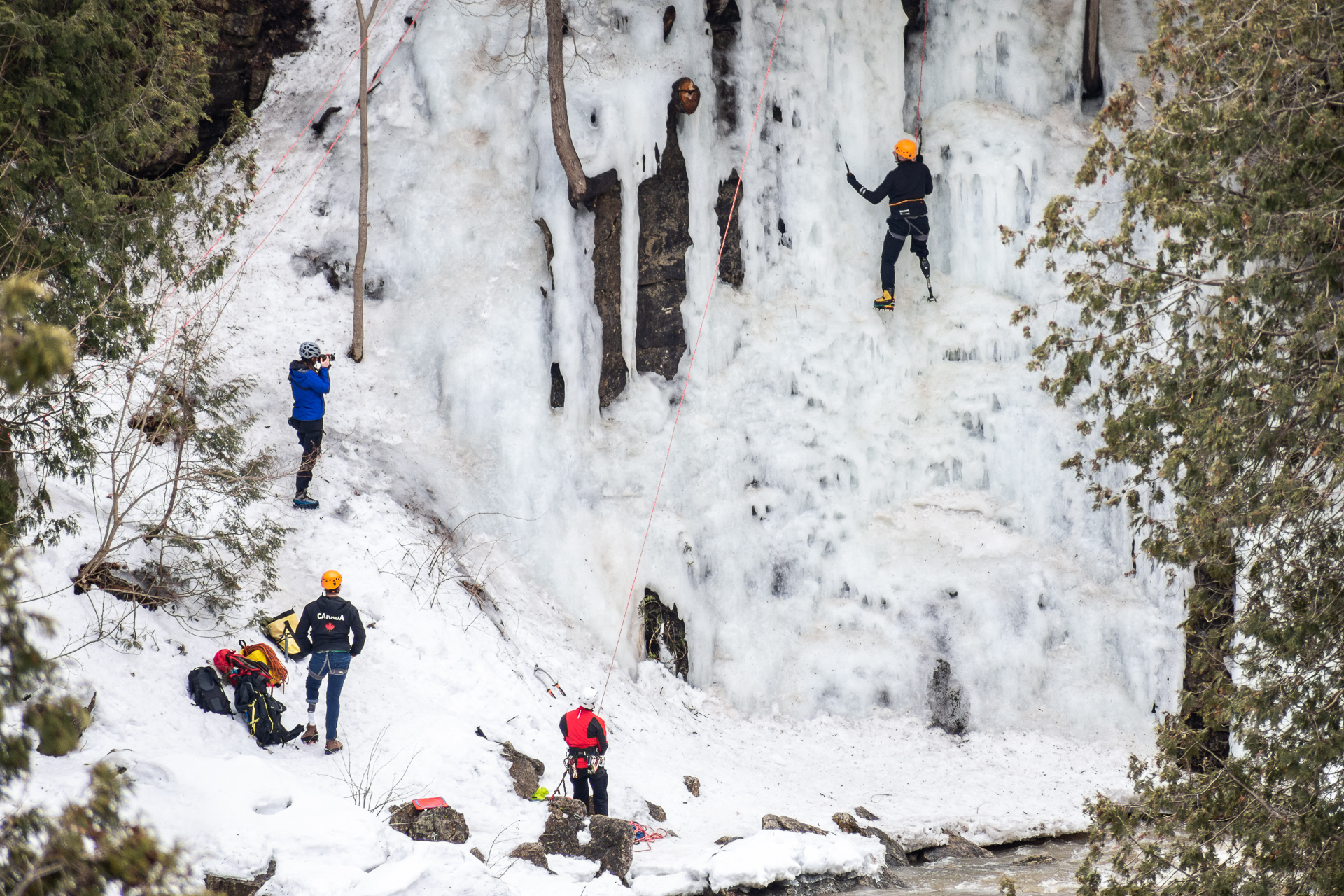ELORA – Shards of ice whiz by Jeremy Ritchie’s face as he swings a pickaxe into a column of ice hanging from an icefall at the Elora Gorge, nearby Victoria Park.
Wearing a look of determination, his eyes focus before he secures another hold with a hard thwack of a second pickaxe.
With both pickaxes in place, Ritchie uses his upper-body muscles to pull up and support his weight.
Lifting his left foot – a prosthetic, fitted with a boot and crampon – he keeps his shin parallel to the icewall before kicking the crampon’s spikes into the ice.
He does the same with his root foot, shifting his weight directly over the crampons, trying not to stand on his toes – that will cause the spikes to slip.
The spiked plates holding firm, Ritchie relinquishes his hold from the pickaxes, seemingly standing on the air punctuated by the springtime surge of the Grand River below.
He readies for the next swings of the axes.
In a matter of minutes, Ritchie has managed to scale an ice column from the base of the gorge to the top – his first ever ice climb.
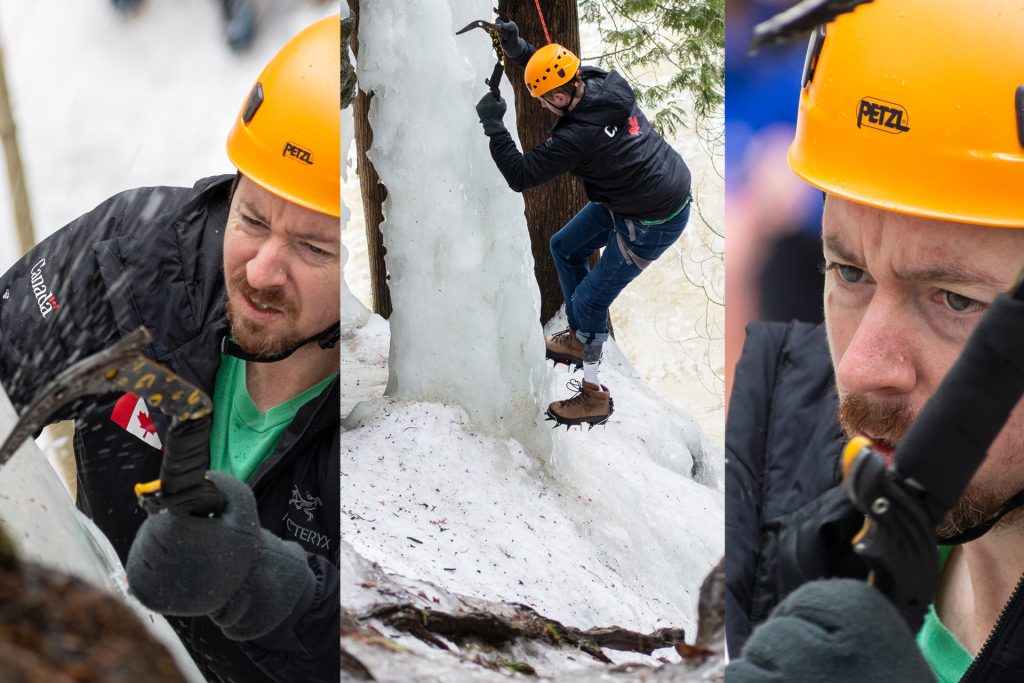
Adaptive climber Jeremy Ritchie begins his first ascent along a column of ice at the Elora Gorge. (Photos by Jordan Snobelen)
He makes it look easy, says One Axe Pursuits owner Frederick Schuett, following the ascent.
When he’s not rigging celebrities, such as Richard Branson, for stunts, or helping Angry Planet’s George Kourounis be the world’s first to descend into the Door to Hell in Turkmenistan, Schuett could be seen as a sort of local ice sculptor.
For the past seven years, he’s used wood and fabric, temporarily mounted on the gorge’s rockface, to fashion and shape water pumped up from the Grand and back down along the rockface through garden hoses in the freezing cold, artificially forming an icefall visible from the St. David Street bridge.
Schuett is also the man responsible for the late-season climb on March 18 that saw two London-area climbers – Ritchie with a below-knee amputation, and another, Jakob Kepka, with an above-knee amputation – ascending high above the craggy valley.
Nearing 16 degrees Celsius that afternoon, the ice held strong for the day’s adaptive climb, paid for by the Arc’teryx outdoors equipment company, and assisted by the climbing community at-large.
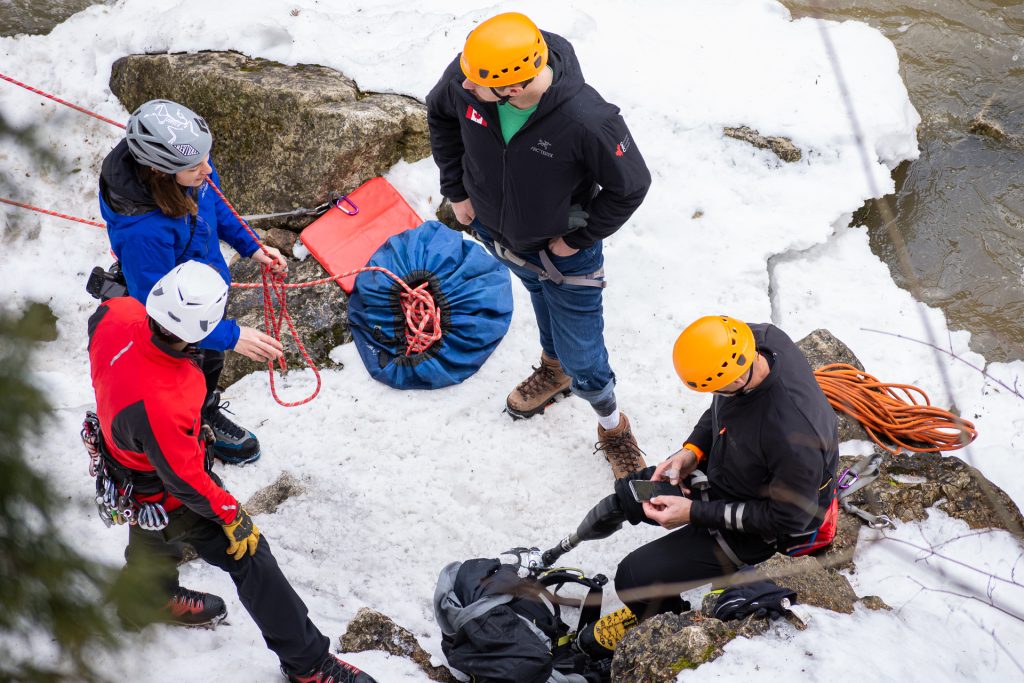
The group discusses the climb. Pictured clockwise from left are: Frederick Schuett of One Axe Pursuits, Kate Stewart with Arc’teryx, and adaptive climbers Jeremy Ritchie and Jakob Kepka. (Photo by Jordan Snobelen)
Around a month before the climb, Kepka was weighing the pros and cons of an osseointegration limb replacement. Although it would eliminate medical issues associated with his current setup, it could also limit his ability to do what he does best: cycling and climbing.
Wanting to cross ice climbing off his bucket list before potentially going through with the procedure, Kepka turned to Google, found One Axe Pursuits and dropped Schuett and his wife Christa a line.
Schuett had experience working with a wide variety of disabilities, but never someone with a prosthetic leg.
Not one for limitations, Kepka said Schuett replied: ‘there’s a way; we’ll figure it out.’
Kepka’s prosthetist attached the toe portion of a crampon to a fabricated plate connecting to Kepka’s Ottobock Genium X3 bionic knee.
In the meantime, Schuett reached out to Kate Stewart, a marketing lead with Arc’teryx, who in turn contacted Ritchie.
“The stoke was pretty high,” said Stewart, who is also an executive director of the Canadian Adaptive Climbing Society, and a certified guide through the Professional Climbing Guides Institute.
“It’s hard for us as able bodied people, or people with two legs, to be able to give advice because we don’t know what that actually feels like,” she explained, adding that missing limb sensation can dramatically affect balance and stability.
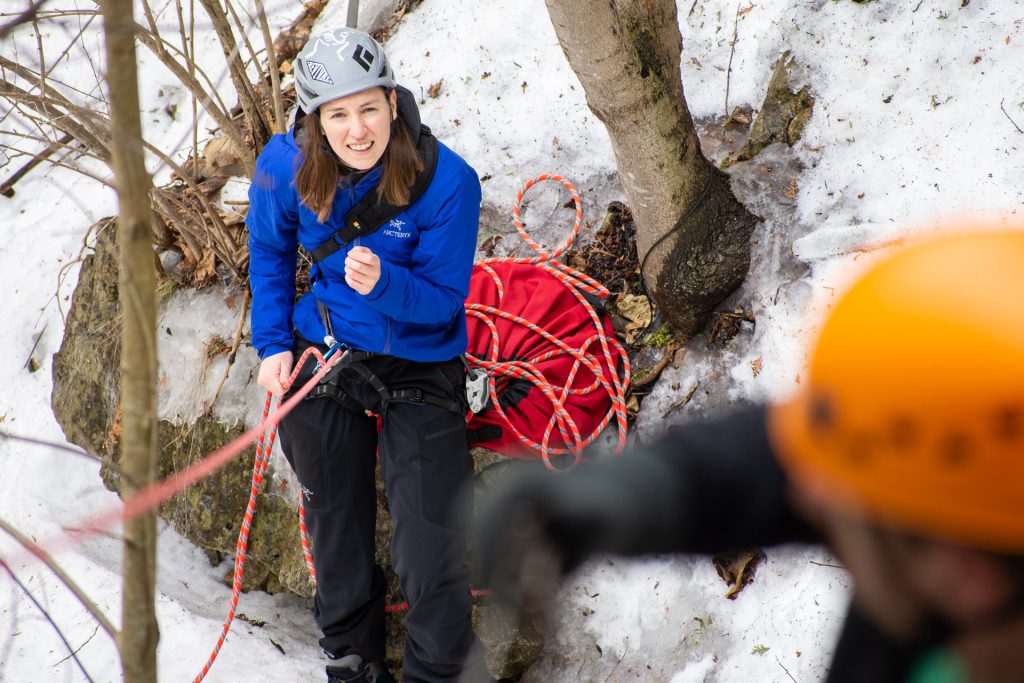
Kate Stewart, a marketing lead with Arc’teryx, executive director of the Canadian Adaptive Climbing Society, and a certified guide through the Professional Climbing Guides Institute, belays for adaptive climber Jeremy Ritchie. (Photo by Jordan Snobelen)
Ritchie and Kepka were able to bounce ideas off each other and collaborate. Although Kepka was the spark, he said everyone coming together to chip in made the day an amazing experience.
Kepka had wanted to try ice climbing long before becoming an amputee.
After five knee surgeries, Kepka had what would be his sixth and final surgery in 2013.
An infection broke out in his leg resulting in the amputation – a life changing and surprisingly liberating milestone for Kepka.
“That thing that was my anchor was gone,” he said.
He was able to return to cycling and climbing, with phantom limb issues – the sensation of an amputated limb still being attached – but he was now relatively pain-free.
“I get a rush from doing things able-bodied people won’t attempt,” he remarked.
With a bad left shoulder, Kepka found difficulty sinking the pickaxe as deep as he would have liked during his ascents.
“So I had to learn to trust what Frederick told me … it’s going to hold,” he said.
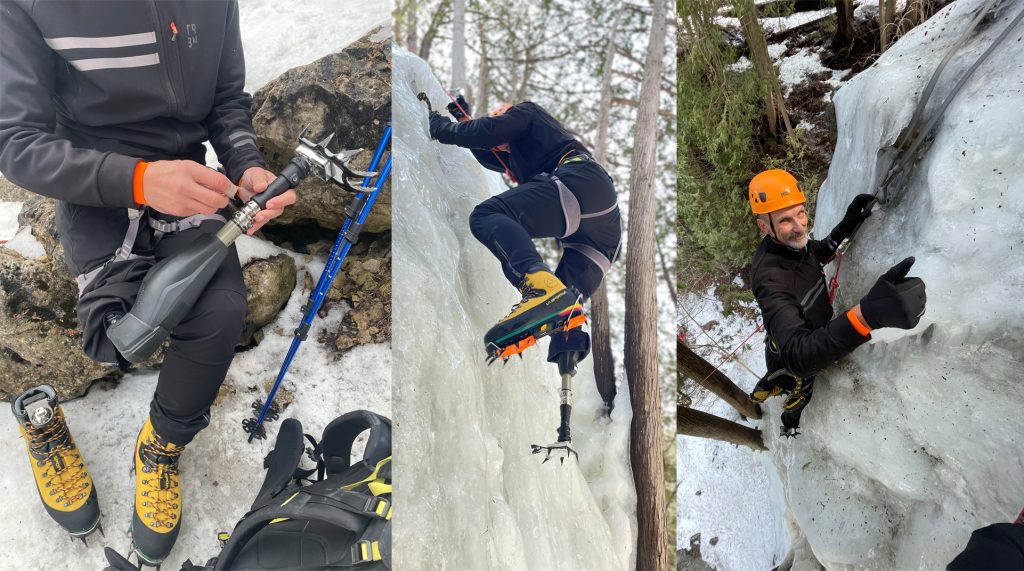
Adaptive climber Jakob Kepka climbs an icefall at the Elora Gorge. (Photos by Frederick Schuett)
The hardest part of the whole thing was the descent, Kepka said, laughing.
With his prosthetic programmed to lock in place, sticking out at roughly 40 degrees, it kept getting stuck and in the way during the descent.
To solve the problem, a rope was tied off to the back of his harness, pulling him from the wall while another line was used to lower.
The Macgyvered crampon absorbed a relentless beating throughout three ascents before snapping under stress during the fourth ascent.
The plate didn’t adequately and evenly distribute Kepka’s weight through the attached crampon.
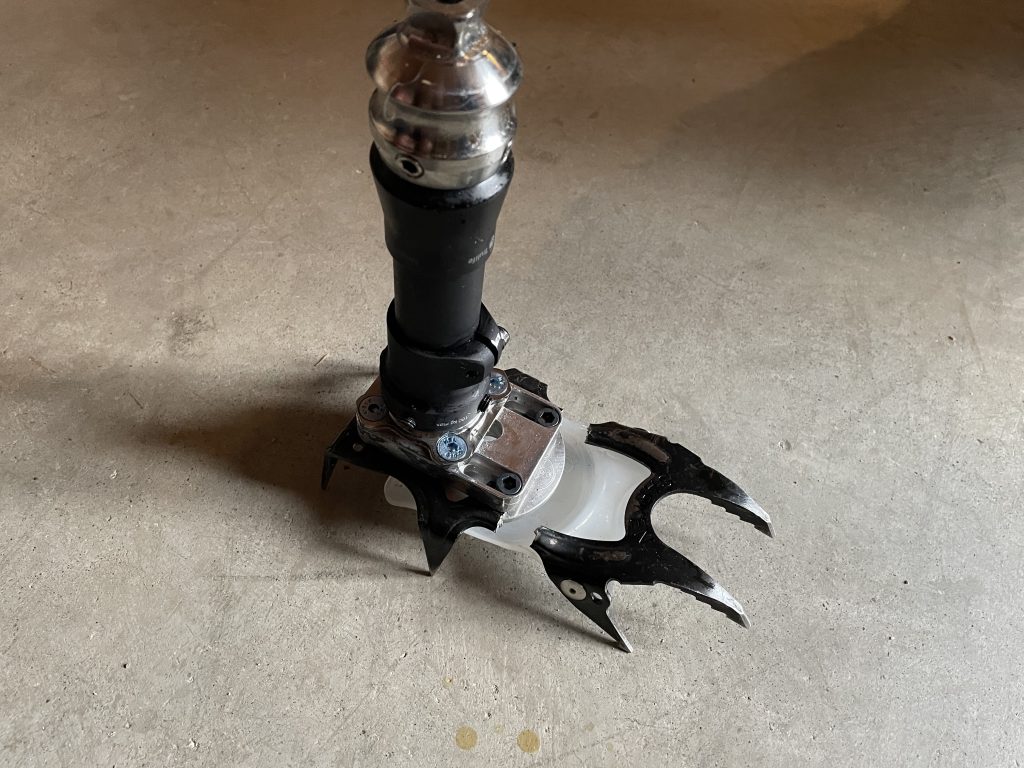
Pictured is the snapped crampon affixed to a custom made attachment. (Photo by Jakob Kepka)
On went the second of a pair of size 14.5 boots loaned to Kepka for the day from another large-footed climber sourced through a Facebook group.
But Kepka struggled with an absence of proprioception and kinesthesia – the brain’s understanding of where the body is in relation to the space around it – and couldn’t tell where the boot now attached to his bionic leg was landing, causing him to constantly look down and check.
For a 64 year-old above-knee amputee, Kepka said, “I probably did really, really well.”
The next item on his bucket list: ascending a mountain.
“As adaptive athletes we’re used to having to adapt to everything,” said Ritchie, who lost his left foot when he was four years-old in a lawn mowing accident.
Now 35, he competes competitively across North America in adaptive rockclimbing – a sport he got hooked on in 2009 and lends itself well to solution-motivated person like Ritchie.
“Every climb is a problem and being an adaptive climber, it’s … taking an able-bodied person’s solution and having to adapt it to solve my own problem,” he explained.
His prosthetic foot has a rubbery flex to it, causing his boot to bounce off the ice when kicking.
“I had to put as much pressure as I can to stiffen my leg so that there’s the least amount of bounce,” he said.
The first two climbs were wearing but by the third, he felt warmed up.
For him, ice climbing felt more “straightforward.”
“I figured I would do okay, but I didn’t think I would catch on that quick,” he said. “I would definitely try it again.”
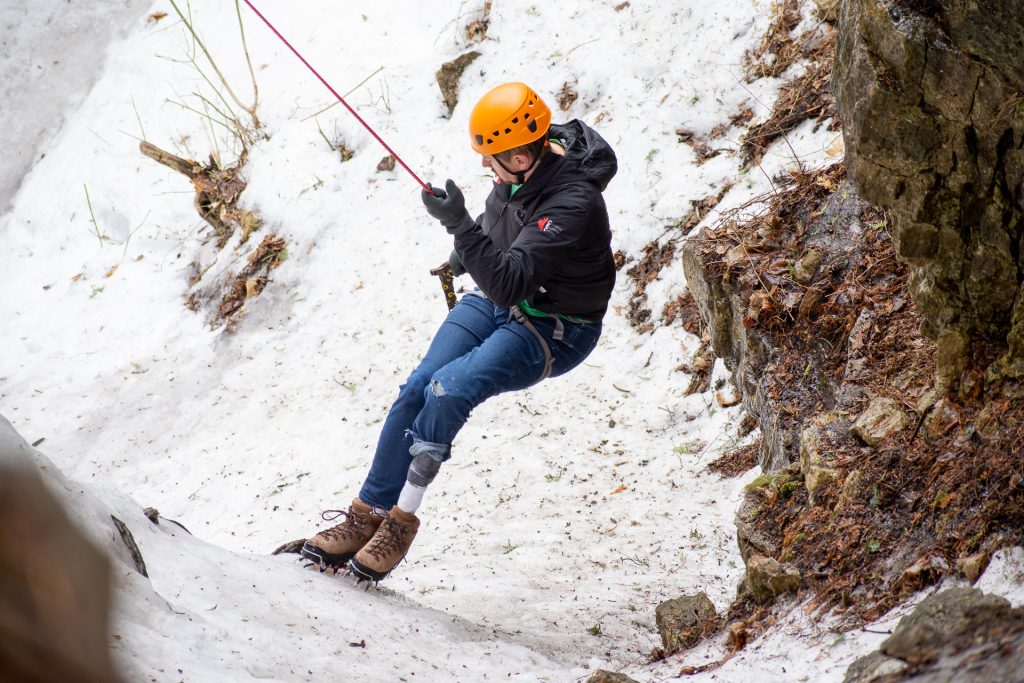
Jeremy Ritchie descends into the gorge after a successful first ascent. (Photo by Jordan Snobelen)
Schuett and Stewart said the men performed better than most able-bodied people for their first time.
“There’s a very steep learning curve for ice climbing, it’s not intuitive at all,” Schuett said.
The swinging of the axes alone can be a tiring challenge for most and many have trouble trusting their feet.
But Kepka and Ritchie, he said, had no problem with the crampons “because they [have] to trust their prosthetic leg every time they step, all the time.”
“We found that they were quite good at adapting and learning to ice climb, because they’re so used to doing that in life,” Stewart added.
People with limb differences, she explained, are used to a society projecting a lack of confidence in their abilities and climbing can provide an empowering, emotionally stirring experience.
Despite society’s virtue signalling in the open, Kepka said he doesn’t believe people have truly accepted that disabled people should live without limitations — a sort of doublethink.
“They expect us to just go for little walks and sit watching reruns,” he joked.
The climbing community, however, is the exception. It’s a group of people who, in their nature, are bound by one question: How can I get to the top?
The answer to which is driven by a shared goal and can-do attitude.
“It constantly proves that all walks of life can overcome challenges and the climbing community is always a big camaraderie. I would miss it if I didn’t have it,” Ritchie said.
After accomplishing five ascents, the group debriefed at One Axe’s Henderson Street location in the former Chalmers Church building, trading notes for around an hour and discussing how things could work better with prosthetics for future climbs.
“We had some good discussions about how we can do it again next year, maybe invite more people out and how we can maybe come up with some funding to get more of those prosthetics to make it more feasible for a larger group and reach more people,” Stewart said.
“I think we need to get a whole adaptive day going,” added Ritchie.
“You don’t know until you try it; there’s so many ways around barriers.”




